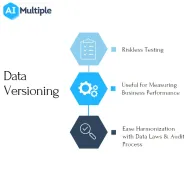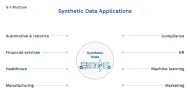Data Quality in AI: Challenges, Importance & Best Practices in '24
The rapid advancement of artificial intelligence (AI) and machine learning has benefited various industries, including finance, healthcare, manufacturing and entertainment. The main obstacle to deploying and carrying out artificial intelligence and machine learning projects and operations, according to a 2019 report, is poor data quality.1
Even the most sophisticated AI algorithms can lead to flawed results and cause poor performance and failure. This article will delve into the importance of data quality in AI, the challenges organizations face, and the best practices for ensuring top-notch data.
What is the importance of data quality in AI?
Data quality is crucial in artificial intelligence because it directly impacts the performance, accuracy, and reliability of AI models. High-quality data enables models to make better predictions and produce more reliable outcomes, fostering trust and confidence among users. See the impact of poor data quality in AI in Figure 1.
Source: SnapLogic2
Figure 1: Impact of poor quality data and analytics
Ensuring data quality also means addressing biases present in the data, which is essential to avoid perpetuating and amplifying these biases in AI-generated outputs. This helps to minimize unfair treatment of specific groups or individuals.
Furthermore, a diverse and representative dataset enhances an AI model’s ability to generalize well across different situations and inputs, ensuring its performance and relevance across various contexts and user groups. Ultimately, maintaining data quality is key to realizing the full potential of AI systems in delivering value, driving innovation, and ensuring ethical outcomes.
“If 80 percent of our work is data preparation, then ensuring data quality is the important work of a machine learning team.”
Andrew Ng, Professor of AI at Standford University and founder of DeepLearning.AI
Professor of AI at Standford University and founder of DeepLearning.AI
Why getting rid of the “garbage in and garbage” concept is crucial for data quality
“Garbage in, garbage out” (GIGO) is a concept in computing and artificial intelligence (AI) that highlights the importance of input data quality. It means that if the input data to a system, such as an AI model or algorithm, is of poor quality, inaccurate, or irrelevant, the system’s output will also be of poor quality, inaccurate, or irrelevant.(See Figure 2).
Source: Shakoor et al., 2019 3
Figure 2: Data quality and standards: “garbage in” data, “garbage out” results.
This concept is particularly significant in the context of AI as AI models, including machine learning and deep learning models, which rely heavily on the data used for training and validation. If the training data is biased, incomplete, or contains errors, the AI model will likely produce unreliable or biased results.
To avoid the GIGO problem, it is crucial to ensure that the data used in AI systems is accurate, representative, and of high quality. This often involves data cleaning, preprocessing, and augmentation, as well as the use of robust evaluation metrics to assess the performance of AI models.
What are the key components of quality data in AI?
- Accuracy: Accurate data is crucial for AI algorithms, enabling them to produce correct and reliable outcomes. Errors in data input can lead to incorrect decisions or misguided insights, causing potential harm to organizations and individuals.
- Consistency: Consistency ensures that data follows a standard format and structure, facilitating the efficient processing and analysis of the data. Inconsistent data can lead to confusion and misinterpretation, impairing the performance of AI systems.
- Completeness: Incomplete data sets can cause AI algorithms to miss essential patterns and correlations, leading to incomplete or biased results. Ensuring data completeness is vital for training AI models accurately and comprehensively.
- Timeliness: Data freshness plays a significant role in AI performance. Outdated data may not reflect the current environment or trends, resulting in irrelevant or misleading outputs.
- Relevance: Relevant data contributes directly to the problem at hand, helping AI systems to focus on the most important variables and relationships. Irrelevant data can clutter models and lead to inefficiencies.
What are the challenges of ensuring data quality in AI?
1-Data collection
Organizations face the challenge of collecting data from various sources while maintaining quality. Ensuring that all data points follow the same standards and eliminating duplicate or conflicting data is complex.
2-Data labeling
AI algorithms rely on labeled data for training, but manual labeling is both time-consuming and prone to errors. The challenge lies in obtaining accurate labels that reflect real-world conditions.
3-Data storage and security
Maintaining data quality also means protecting it from unauthorized access and potential corruption. Ensuring secure and robust data storage is critical for organizations.
4-Data governance
Organizations often struggle with implementing data governance frameworks that effectively address data quality issues. A lack of proper data governance can lead to siloed data, inconsistency, and errors.
Best practices for ensuring data quality in AI
1-Implement data governance policies
A robust data governance framework should be in place to define data quality standards, processes, and roles. This helps create a culture of data quality and ensures that data management practices are aligned with organizational goals.
2-Utilize data quality tools
Data quality tools can automate data cleansing, validation, and monitoring processes, ensuring that AI models have access to high-quality data consistently.
3-Develop a data quality team
Having a dedicated team responsible for data quality ensures continuous monitoring and improvement of data-related processes. The team can also educate and train other employees on the importance of data quality.
4-Collaborate with data providers
Establishing strong relationships with data providers and ensuring their commitment to data quality can minimize the risk of receiving low-quality data.
5-Continuously monitor data quality metrics
Regularly measuring and monitoring data quality metrics can help organizations identify and address potential issues before they impact AI performance.
Reach us if you have further questions
External Links
- 1. Refinitiv. “Smarter Humans. Smarter Machines.” Insights from the Refinitiv 2019 Artificial Intelligence / Machine Learning Global Study. 2019
- 2. Snaplogic “The State of Data Management – The Impact of Data Distrust”
- 3. Shakoor, Nadia & Northrup, Daniel & Murray, Seth & Mockler, Todd. (2019). “Big Data Driven Agriculture: Big Data Analytics in Plant Breeding, Genomics, and the Use of Remote Sensing Technologies to Advance Crop Productivity.”



Comments
Your email address will not be published. All fields are required.